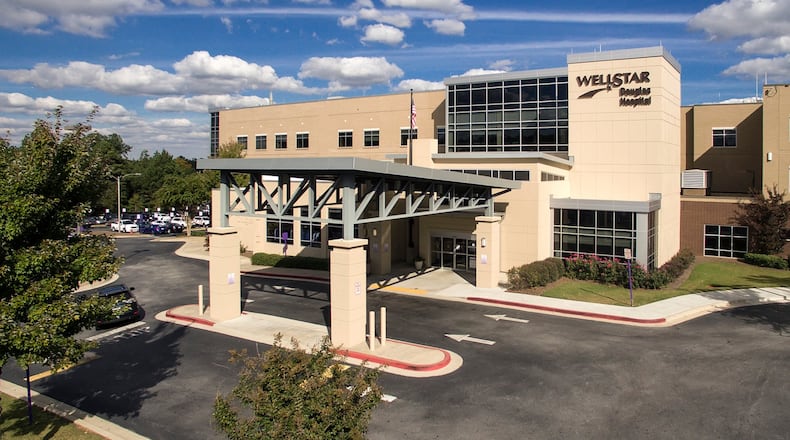Do hospitals pay their lowest-level employees a fair wage? Do they train doctors to treat the underserved? Do they treat enough people who can't pay, or people of color who traditionally have less access to medical care?
Such questions are rarely or never emphasized in evaluating hospitals, according to the Lown Institute, and it hopes to change that. The Massachusetts-based institute has spent a year developing a study of U.S. hospitals’ equity and civic responsibility across the United States — and when it was released this month, a Georgia hospital nearly topped the list.
Among 3,282 U.S. hospitals the study measured, Wellstar Douglas Hospital in Douglasville ranked sixth in the nation for measures like treating poor patients and paying its lowest-level employees fairly compared to its top leadership. Within Georgia, Wellstar satellite hospitals occupy four of the top five spots overall.
Some hospital industry advocates criticized the report as unhelpful to consumers shopping for hospital care. The authors say that wasn't the point, and stress that hospitals also need to be seen as the social and economic community anchors they are.
“We didn’t mean this to be a ranking tool for patients to pick their care,” said Dr. Vikas Saini, a cardiologist who is president of the Lown Institute.
The ranking is the first, he said, to measure the degree to which a hospital is caring for patients of color and of lower income or education.
“This is more for all of us to think about hospitals in a different way and begin to imagine what it could be like if all hospitals really hit those stretch goals across the board, and what kind of a health care system we could have if we did that,” he said. “We didn’t realize how much of a challenge it would be to find hospitals that do well across these measures. But we did. There are hospitals that do that.”
Community benefit
All communities benefit every time their hospitals heal a sick person. But for nonprofit hospitals, demonstrating a broader "community benefit" is a legal requirement. In return they get breaks on federal corporate income taxes, state sales taxes and local property taxes.
They get those breaks even if they make a lot of extra money, like some Atlanta-region hospitals do, or pay their CEO $5 million a year, as Northside Hospital does.
Sara Rosenbaum, a health law professor at George Washington University who studies community benefit and advised on the study, at one time counted up the estimated tax benefit to nonprofit hospitals in the U.S. It was $24.6 billion in one year, 2011. She estimates it’s about 50% higher now.
In Georgia alone, that figure was $469 million that hospitals saved by not paying taxes in 2011. And that was before some recent hospital expansions in metro Atlanta.
Lown, a non-partisan think think tank that emphasizes healing over profits, included all kinds of hospitals on its list, including those run by for-profit corporations. Many of those hospitals also are subject to some requirements for community good, such as having to screen and treat every patient who comes to their emergency departments, regardless of ability to pay. For-profit hospitals also pay taxes. But they benefit from federally funded research that leads to the discovery of medical products they sell, and from the training of the medical professionals they employ, the authors point out.
The researchers at Lown question how the concept of community benefit has come to be shaped. Hospitals focus on meeting the IRS’s legal definition, which can include the amount of free or discounted care they give patients, medical profession training and other efforts.
But, Saini asks, if a hospital is going to build centers training and employing well-paid prestigious specialists, is that the same community benefit as training large numbers of general practitioners and making sure they go out to serve poor rural communities? Which effort should get the big tax break?
Ranking well, or not
Among the nation's safety net hospitals, Grady Memorial Hospital was ranked No. 64. The ranking of the 50 best major teaching hospitals didn't include any from Georgia.
Emory University Hospital fell flat in the study, ranked in the middle of the pack both in Georgia and nationally. In a statement, Emory said its community contributions were not properly counted because it provides much of them through other branches of Emory University, such as the Woodruff Health Sciences Center.
“This is distinct from that of our Atlanta peers, who do not support academic partners in their community investments,” Emory said. “Emory Healthcare is dedicated to providing the safest and highest quality health care to the diverse patients and families we are privileged to serve.”
Indeed, Emory's clinical outcomes ranked high in the study. Clinical outcomes didn't weigh as heavily in this study, however, unlike typical hospital rankings.
The American Hospital Association was more direct in condemning the study altogether, calling it a “hodgepodge” that “uses confusing definitions and makes sweeping conclusions about hospital performance based on an incomplete set of data sources.”
“The fact is that this report falls far short of criteria the AHA has endorsed for quality report cards and rating systems,” its statement said. “That includes appropriate measures that fit the purpose of the report card, valid data sources, and transparent and easy to replicate scoring methodologies.”
One source of the study’s data was the AHA, Lown said.
Wellstar Health System in a statement said that it’s worth looking beyond the traditional measures for hospitals that focus purely on clinical outcomes. It plans to use the study to look at what other hospitals are doing that can also help it improve. “Our care extends beyond the walls of Wellstar,” it said, noting Wellstar’s Center for Health Equity and its work with hundreds of community organizations.
“Look at things differently”
In Douglas County, Amanda Bryant was not surprised to hear that Wellstar Douglas Hospital ranked so high on such measures.
Bryant is the executive director of the county’s resource center for human-services charities, Community Organizing Resources for Excellence.
“We’ve always had someone who was very community minded at the highest level of the hospital,” she said. If one of her organizations needs something to serve its people, she knows she has a good chance of help from the hospital.
“That’s what I want,” she said. “That’s what I consider to be big. They’re not the biggest, they’re not even the greatest to be honest, but the bottom line is they have Douglas County first and foremost on their minds.”
She also notes that the hospital is a major employer.
“A hospital job in the county is a very good job,” she said. “I can’t think of any hospital job that doesn’t at least provide a livable wage.”
It matters, since it is one of a handful of anchors in the community, she said.
“That means that family is not going to be impoverished,” and they have the means to live with better food and activities. And that, she said, impacts health.
Saini said he was sure Lown’s first report could be improved on, and he hopes critics will weigh in — as well as consider the meaning of it.
“What we’re saying is, let’s look at things differently,” he said.
READ THE RANKINGS: The Lown Hospitals Index
Study: Top Civic Hospitals
The Lown Insitute has produced a first-of-its kind ranking of U.S. Hospitals. Using 2017 and 2016 measurements to rank accomplishments such as pay for the hospital’s lowest-ranking workers compared to the highest, or how much it treats low-income and minority patients, it added those to more traditional measures such as patient outcomes and level of unnecessary care. These were the top five hospitals overall in Georgia. They are listed with their national ranking out of 3,282 U.S. hospitals measured.
6th Wellstar Douglas Hospital, Douglasville
- Civic leadership A+
- Value of care C+
- Patient outcomes A+
35th Wellstar Paulding Hospital, Hiram
- Civic leadership A
- Value of care B+
- Patient outcomes A
170th Piedmont Athens Regional Medical Center, Athens
- Civic leadership C
197th Wellstar Cobb Hospital, Austell
- Civic leadership A
- Value of care C-
- Patient outcomes A
433rd Wellstar Spalding Regional Hospital, Griffin
- Civic leadership A+
- Value of care C
- Patient outcomes B
About the Author
The Latest
Featured



